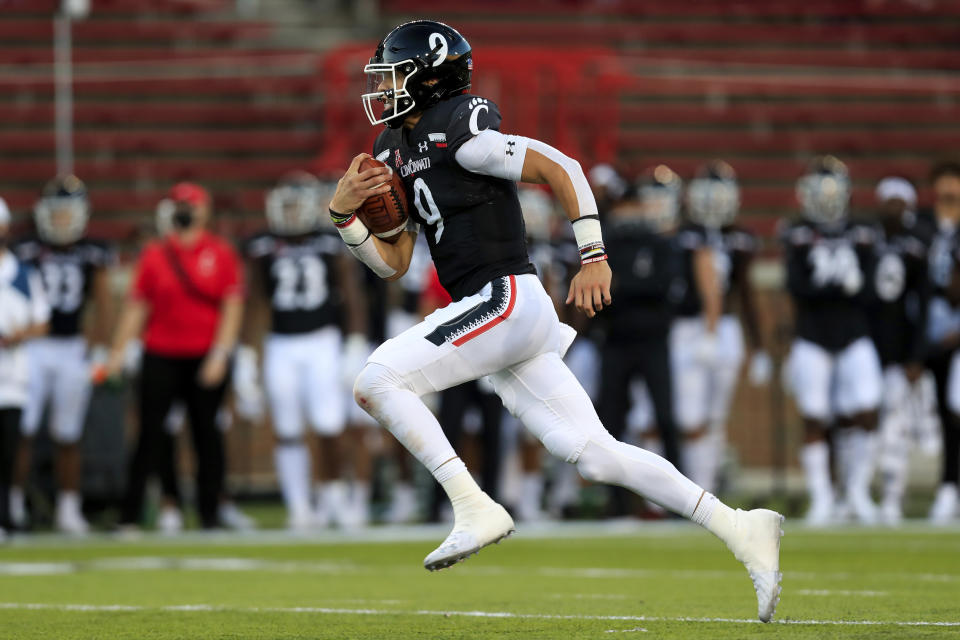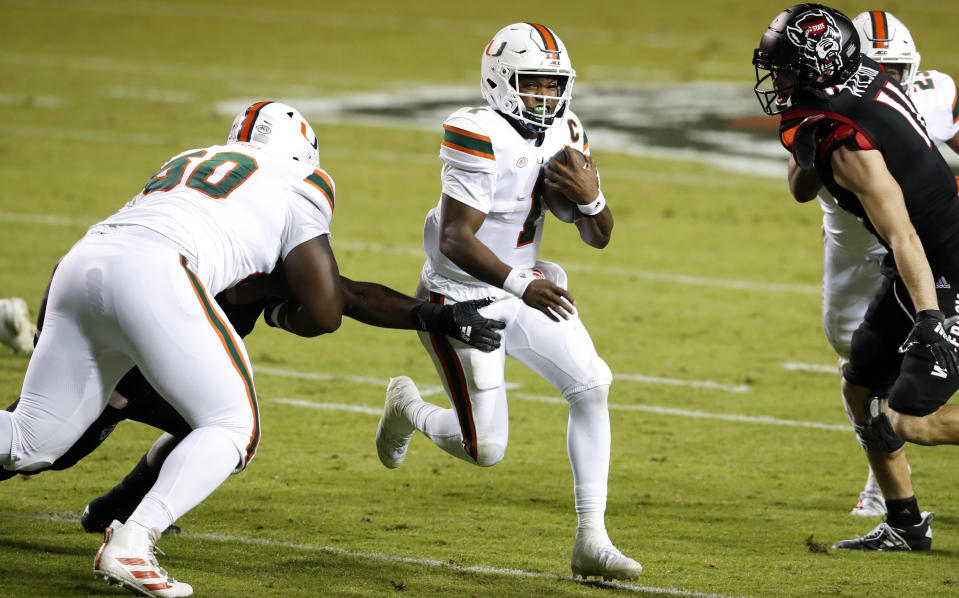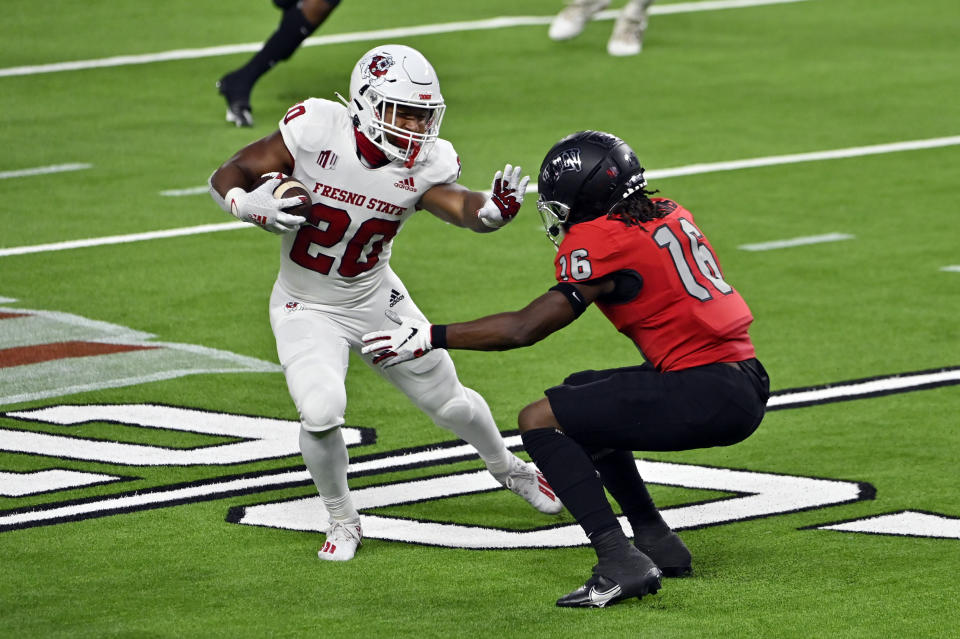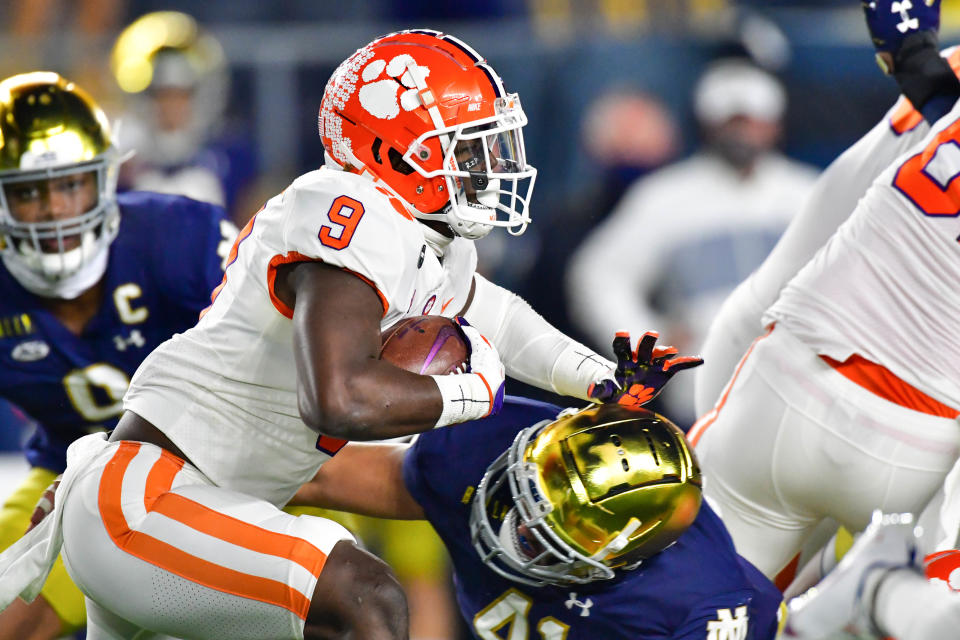NFL draft winners and losers: Intriguing Cincinnati QB Desmond Ridder is on the rise
We have as close to a full college football season happening now, even with the slew of games canceled for COVID-related reasons. That last part is a bummer.
But seeing the Pac-12, MAC and other conferences return to action over the past week has been a game changer for fans and NFL scouts alike. It feels as close to a real season as we’ve had in 2020.
Here are some draft-related observations we have from this past weekend of action:
Winners
Cincinnati QB Desmond Ridder
The QB hierarchy has been altered a bit since our summer projections, and one name in that mix we don’t want to overlook is Ridder. He’s going to be a bit polarizing in some circles, but Ridder possesses the size, live arm and athletic skill to be a very interesting prospect.
Ridder turned in a big first half in Cincinnati’s dominant win over Houston, as the Bearcats kept rolling on their impressive season. They’re a tough team to defend because of Ridder’s dual-threat skill, and I believe he’s helped his cause out as a prospect quite a bit this season.
Ridder’s final passing numbers (17 of 27 passing, 162 yards, one touchdown, one interception) don’t tell the whole story of how effective he was Saturday.
The 6-foot-4, 207-pound passer sat most of the fourth quarter, had two very catchable passes dropped and his INT came on an end-of-half Hail Mary. Ridder also ran for 103 yards and three scores. Many of those yards came on scrambles, not designed runs, when there were no open receivers.

I see Ridder somewhere on the Colin Kaepernick-Ryan Tannehill spectrum as a prospect, lacking the elite arm strength of Kaepernick and Tannehill’s passing rhythm. But with continued reps and development, Ridder could be a very interesting developmental passer.
There are three tiers shaping up for the 2021 class. At the top, to me, are Clemson’s Trevor Lawrence, Ohio State’s Justin Fields and BYU’s Zach Wilson, in some order. Just below them is North Dakota State’s Trey Lance (although he might be in the uppermost category for some). Then there are Florida’s Kyle Trask and Alabama’s Mac Jones a tier below that.
Ridder could jump into that Trask-Jones tier, I believe. He’s not quite as polished as Jones and lacks their deeper passing touch and consistency now. But count me in on Ridder, who has become the prospect many were hoping Texas A&M’s Kellen Mond — who earned some second- and third-round grades this summer — would be.
QB-needy teams
Lawrence was great before his COVID diagnosis. Fields has been tremendous so far, with 12 incompletions (with four OSU drops) in 12 quarters of play — no matter who it was against, that’s absurd. Wilson has been one of the great stories of college football.
Trask is coming off his best game, even with a few dicey throws in harm’s way. Jones and Ridder have been success stories this season; both are on the rise as prospects.
For whatever QB prospects have disappointed this season, the 2021 class at the position looks highly promising. Perhaps we get four quarterbacks in the top 10 even, with Lawrence, Fields, Wilson and maybe Lance.
After that, there are three more who could land in the late-first-to-early-second range. Since the 2017 NFL draft, we’ve had three or more quarterbacks land in the top 15 selections every year. All signs point to 2021 being the same.
Not all of them will work out, of course. But we suspect teams won’t be dramatically reaching for QB prospects when they take them high next spring.
Miami QB D’Eriq King
His quest to be an NFL quarterback still has some big hurdles. But on Saturday against North Carolina State, we saw a very confident thrower who was thriving with the placement of his deep balls.
King’s passes came out on time, and they were dropped in the bread basket more often than not, allowing the receivers to catch them without breaking stride. Two of his best throws were his second TD pass of the game on a “go” route (where King was hit on the facemask right as he threw) and on a pretty slot fade TD throw on a little “smash” concept against two-high coverage to give the Hurricanes a 21-14 lead.

Neither were particularly difficult reads. But King’s touch and ball placement were impressive all game, completing 31 of 41 passes for 430 yards, five TDs and no picks. He also scrambled for 150 yards and a score.
Is he an NFL quarterback? It might take a true believer to pound on a table to start King out there, and he might not be a Year 1 contributor in that scenario. Many people in the NFL believe King’s best path to the NFL could be as a receiver/returner/trick-play option. But this game could keep a few minds ajar to the QB possibility come draft time.
BYU’s other standouts
We’ve waxed poetic about the season Zach Wilson has had to date, and — we think — for good reason. But we wanted to give a little shine to some of the Cougars’ other standout performers, some of whom will start to become more household names as long as BYU keeps winning.
LT Brady Christensen has been a stud so far. He looks light and agile in pass protection and very effective with his hands and leverage as a run blocker. We think Christensen is making a case to possibly declare early and beef up a good OT class even more. His tape against Utah’s Bradlee Anae last season was impressive and helps offset the lack of elite pass-rush opponents this season.
Senior Chandon Herring has been a bit up and down shifting back and forth between right tackle and right guard, but he is the Cougars’ second-most interesting blocker up front. Also in that OL mix are senior RG Tristen Hoge, who has looked good since coming back from injuries, even if durability questions will follow him. And redshirt junior James Empey looks solid at center. All three profile as Day 3 prospects now.
On defense, DT Khyiris Tonga had been a bit quieter than we had hoped prior to Saturday. But in the win over Boise State, Tonga was electric with several impressive rushes (including an athletic sack for a 6-2, 326-pound nose tackle) and a number of run stops.
The big riser for the Cougars on this side of the ball has been redshirt senior S Troy Warner, who has been severely hindered the past few years by a freak Lisfranc injury that required three surgeries to finally get right. The results have borne out on the field. The brother of 49ers linebacker Fred Warner has been the Cougars’ best all-around defender this season and appears fully healthy.
The 6-1, 201-pound Warner was given UDFA grades over the summer, and he’ll still be closely looked at during the medical process. But we think he’s entered the early Day 3 mix now.
CB Chris Wilcox, LB Isaiah Kaufusi, EDGE Zac Dawe and S Zayne Anderson also are on NFL radars. The only Cougars defender in the 2021 draft mix who has been a bit disappointing, we think, has been Kavika Fonua. The 25-year-old Fonua — nicknamed “Gramps” — has tried to make the rare transition from inside linebacker to slot corner, and it’s been a trial by fire so far.
Fresno State RB Ronnie Rivers
If you’re a fan of the undersized playmaker, then attune your eyes to the Bulldogs’ dynamo offensive weapon. Rivers isn’t quite 5-foot-8, and he likely isn’t more than 190 pounds. But the shiftiness, burst, toughness, vision and versatility are all off the charts.
After entering the season with mostly late-round grades, Rivers almost certainly has helped his cause through Fresno’s first three games. In addition to his eight touchdowns (six rushing, two receiving), he has averaged 161 yards from scrimmage per game and has been a threat on punt returns (15-yard average).

On Saturday, Rivers scored four times against UNLV. He rolled up 133 rush yards on 19 carries and caught six passes for 99 yards in the 40-27 victory, putting the game away with his 10-yard TD run early in the fourth quarter.
Lining up everywhere — in the backfield, out wide, in the slot, at punt returner and even as a Wildcat QB — Rivers has carved out a crucial role in his four college seasons as one of the best Mountain West players. He reminds us a bit of the Chicago Bears’ Tarik Cohen and almost certainly will be a fan favorite for whichever team that drafts him.
Oklahoma EDGE Ronnie Perkins
Forget for a moment that Perkins’ performance on Saturday came against lowly Kansas. The more we’ve done this, the less we’ve concerned ourselves with the opponent — who prospects play against matters, of course, but we can also factor that in when they dominate against lesser players and teams.
Perkins put on an absolute show Saturday against the Jayhawks with four tackles, 1.5 sacks and three quarterback hits. And what those numbers don’t show: two run stops right at the line of scrimmage for no-gains and nearly a half-dozen other pressures in a little more than one half of play.
The 6-3, 247-pound Perkins is a junior and could stay in school next year. But we wouldn’t at all be shocked to see him enter the 2021 draft mix if he keeps humming. His size is a concern, and Perkins will have to answer for a suspension prior to last year’s playoff semifinal loss to LSU.
But this is a quality run defender and emerging pass rusher whose stock continues to rise with his early play on the field.
Losers
Clemson RB Travis Etienne
This is the tough part about scouting: when to look past the raw production and traits and raise concerns about a player that don’t show up in the box scores or measurements.
As a runner, Etienne is electric. He has the burst required to be an NFL showcase piece. Etienne’s improvement in the passing game has been clear this season. His season-long production will be great and his workouts should be tremendous. In short, Etienne is a big play waiting to happen.
But this is now back-to-back games where Etienne has had damaging mental and physical mistakes that cost his team.
Last week against Boston College, it was a goal-line fumble that the Eagles ran back 99 yards for a score. On Saturday, Etienne had another fumble in an exchange with freshman QB D.J. Uiagalelei — although we can certainly blame the quarterback change a bit on this — that led to Notre Dame points.

But Etienne’s biggest mistake, we feel, was running out of bounds late on a third-down run as Clemson was trying to ice its lead late. The clock stopped with 1:48 to go, Notre Dame had two timeouts left, and they tied the game, sending it to overtime. Dabo Swinney appeared quite irritated with Etienne’s decision at the moment.
Etienne was bottled up all night (18 runs for 28 yards, eight receptions for 57 yards), although the interior of the Tigers’ offensive line can be blamed for some of that. Amazingly, Etienne actually netted 52 yards after contact (!) as he was often hit in the backfield and taken down for five negative runs accounting for minus-19 yards.
He did score to give Clemson the lead late in the fourth quarter, also hauled in a beautiful pass in traffic to convert a third down and nearly housed a kick-six attempt on a missed field goal. But we can’t get over Etienne’s critical mistakes the past two weeks in his evaluation. For a back who returned to school in his quest to land in Round 1, those mistakes could hurt his draft grade as much as some of his best traits help it.
Ohio State CB Shaun Wade
Saturday’s game against Rutgers was actually a better performance from Wade, who struggled in the first two games of the season. Wade moved from the slot to outside corner this season, coming back (after initially opting out) to prove he’s a first-round corner.
But has that happened yet? We’re not certain. Wade made our initial first-round mock, and for all we know he could improve off his first few performances of the season — especially in a tough night two weeks ago against Penn State’s Jahan Dotson — and remain in that top-32 picture.
For now, though, Wade has work to do to stay there. Even still, we think it’s quite possible.
USC WR Tyler Vaughns
It’s one game, and we are not going to freak out too much. But Vaughns looked a little sluggish to us in his routes — and clearly the third-best receiver on the team behind Amon-Ra St. Brown and Drake London — in Saturday’s narrow-escape win over the Sun Devils.
Vaughns’ longest catch went for 20 yards. But on the play, he failed to secure the ball as Arizona State CB Chase Lucas came in from behind to strip it. That turnover led to an ASU field goal.
Vaughns hauled in seven catches but for only 53 yards. He was tackled short of the sticks on four of them, even though his 14-yard catch and run on fourth-and-3 (when the Trojans trailed by 13 with four minutes left) was a sneaky big play.
We just want to see Vaughns display more burst and awareness.
Oregon DT Jordon Scott
College football and draft fans might know Scott’s name a bit, as the 6-foot, 328-pound nose tackle for the Ducks has started 38 games in his career, has made a few all-Pac-12 postseason teams and is quite recognizable with his stout frame and long hair flowing out the back of his helmet.
But we have been somewhat underwhelmed in our studies of Scott and frankly wonder how appealing he will be to NFL teams who appear to be moving away from the shorter-stouter run-stopping interior linemen. Scott’s performance on Saturday against Stanford didn’t change much of that view for us.
Scott barely played half the snaps (31 out of 60), coming off the field in some passing situations. He looked pretty slow and monotone as a rusher to us, only really standing out on one play where Scott stuck with a screen play to make the tackle from behind.
Scott’s short arms, unimpressive stamina and limited burst as a rusher all hinder his draft value. He came into the season earning some mid-to-late Day 3 grades and will have to finish stronger this season than he showed in the opener.
More from Yahoo Sports:

 Yahoo Sport
Yahoo Sport 





































